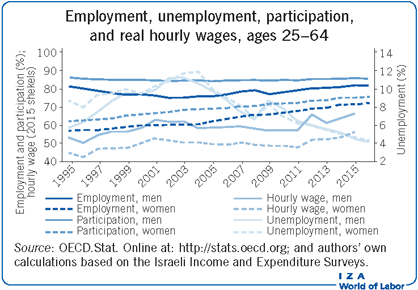Elevator pitch
Following a decline in employment and participation rates during the 1980s and 1990s, Israel managed to reverse these trends during the last 15 years. This was accompanied by a substantial decrease in unemployment. New labor force participants are mostly from the low end of the education distribution, and many are relatively old. They entered the labor force in response to cuts in welfare payments and increases in the mandatory retirement age. Net household income for all population groups has increased due to growth in labor income; however, inequality between households has increased.

Key findings
Pros
There have been significant increases in both men and women’s employment and participation rates, and unemployment has decreased to its natural level of around 4%.
Real earnings of the average and median worker have risen.
Net real household income increased for all percentiles and all population groups.
Employment gaps between Arabs and Jews have narrowed.
Employment gaps between ultra-Orthodox and non-Orthodox Jews have narrowed.
Cons
Male participation is still lower than in the OECD average.
Wide gaps in earnings persist between the various population groups.
There is high and growing income inequality between households.
The employment rate for Arabs is still below that of the Jewish population.
The employment rate of ultra-Orthodox Jews is still below that of the non-Orthodox population.